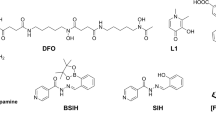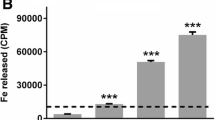Abstract
The iron content of the substantia nigra pars compacta increases in the brains of Parkinson’s disease patients. Hence, its removal by iron chelators may retard the progression of the disease. However, information on the ability of clinically available iron chelators to cross the blood brain barrier and be neuroprotective is limited. In this present study three iron chelators, which are currently approved for clinical use, namely the hexadendate, deferrioxamine, the bidentate deferiprone and the tridendate chelator deferasirox have been investigated for their efficacy to induce neuroprotection. Previous studies have shown that both deferiprone and deferrioxamine exert neuroprotection in the 6-hydroxy dopamine (6-OHDA) model but no such studies have investigated deferasirox. Focal administration of deferasirox (0.5, 2 and 10 μg) into the substantia nigra pars compacta of rats significantly attenuated the loss of dopaminergic neurons and striatal dopamine content resulting from 6-OHDA toxicity. Systemic administration of deferasirox (20 mg/kg), deferiprone (10 mg/kg) or deferrioxamine (30 mg/kg), to the 6-OHDA rat model of Parkinson’s disease, significantly attenuated the loss of dopaminergic neurons and striatal dopamine content. Further studies to comprehend the action of these chelators showed that local application of either 0.4 mM deferrioxamine, or 1 mM deferasirox, via a microdialysis probe into the striatum, prior to that of 200 μM 6-OHDA, prevented the generation of hydroxyl radicals. Our results confirm that the administration of these chelators show therapeutic efficacy and should be considered as therapeutic agents for the treatment of Parkinson’s disease.






Similar content being viewed by others
References
Avramovich-Tirosh Y, Amit T, Bar-Am O, Zheng H, Fridkin M, Youdim MB (2007) Therapeutic targets and potential of the novel brain–permeable multifunctional iron chelator-monoamine oxidase inhibitor drug, M-30 for the treatment of Alzheimer’s disease. J Neurochem 100:490–502
Ben-Shachar D, Eshel G, Finberg JP, Youdim MB (1991) The iron chelator deferrioxamine (Desferal) retards 6-hydroxydopamine-induced degeneration of nigrostriatal dopamine neurons. J Neurochem 56:1441–1444
Boddaert N, Le Quan Sang KH, Rotig A, Leroy-Willig A, Gallet S, Brunelle F, Sidi D, Thalabard JC, Munnich A, Cabantchik ZI (2007) Selective iron chelation in Friedreich ataxia: biologic and clinical implications. Blood 110:401–408
Cappellini MD, Bejaoui M, Agaoglu L, Porter J, Coates T, Jeng M, Lai ME, Mangiagli A, Strauss G, Girot R, Watman N, Ferster A, Loggetto S, Abish S, Cario H, Zoumbos N, Vichinsky E, Opitz H, Ressayre-Djaffer C, Abetz L, Rofail D, Baladi JF (2007) Prospective evaluation of patient-reported outcomes during treatment with deferasirox or deferoxamine for iron overload in patients with beta-thalassemia. Clin Ther 29:909–917
Carman LS, Gage FH, Shults CW (1991) Partial lesion of the substantia nigra: relation between extent of lesion and rotational behaviour. Brain Res 553:275–283
Carvey PM, Zhao CH, Hendey B, Lum H, Trachtenberg J, Desai BS, Snyder J, Zhu YG, Ling ZD (2005) 6-Hydroxydopamine-induced alterations in blood-brain permeability. Eur J Neurosci 22:1158–1168
Crapper McLachlan DR, Dalton AJ, Kruck TP, Bell MY, Smith WL, Kalow W, Andrews DF (1991) Intramuscular deferrioxamine in patients with Alzheimer’s disease. Lancet 337:1304–1308
Crichton RR, Ward RJ (2006) Metal-based neurodegeneration: from molecular mechanisms to therapeutic perspectives. Wiley, Chichester, pp 21–52
Datla KP, Bennett RD, Zbarsky V, Ke B, Liang Y, Bahorun HT, Aruoma OI, Dexter DT (2004) The antioxidant drink “effective microorganism-x (EM-X)” pre-treatment attenuates the loss of nigrostriatal dopaminergic neurons in a 6-hydroxydopamine lesion model of Parkinson’s disease. J Pharma Pharmacol 56:649–654
Dexter DT, Wells FR, Agid F, Agid Y, Lees AJ, Jenner P, Marsden CD (1987) Increased nigral iron content in postmortem parkinsonian brain. Lancet 2:1219–1220
Duce JA, Bush AI (2010) Biological metals and Alzheimer’s disease: implications for therapeutics and diagnostics. Prog Neurobiol 92:1–18
Frank-Cannon TC, Alto LT, McAlpine FE, Tansey MG (2009) Does neuroinflammation fan the flame in neurodegenerative diseases? Mol Neurodegener. doi:101186/1750-1326-4-47
Freinbichler W, Colivicchi MA, Fattori M, Ballini C, Tipton KF, Linert W, Della Corte L (2008) Validation of a robust and sensitive method for detecting hydroxyl radical formation together with evoked neurotransmitter release in brain microdialysis. J Neurochem 105:738–749
Gerlach M, Double KL, Youdim MB, Riederer P (2006) Potential sources of increased iron in the substantia nigra of parkinsonian patients. J Neural Transm Suppl 70:133–42
Halliwell B (2001) Role of free radicals in the neurodegenerative diseases: therapeutic implications for antioxidant treatment. Drugs Aging 18:685–716
Hanson LR, Roeytenberg A, Martinez PM, Coppes VG et al (2009) Intranasal deferoxamine provides increased brain exposure and significant protection in rat ischemic stroke. J Pharmacol Exp Therapeut 330:679–686
Hua Y, Keep RF, Hoff JT, Xi G (2008) Deferoxamine therapy for intracerebral hemorrhage. Acta Neurochir Suppl 105:3–6
Kakhlon O, Manning H, Breuer W, Melamed-Book N, Lu C, Cortopassi G, Munnich A, Cabantchik ZI (2008) Cell function impaired by frataxin deficviency are restored by drug-mediated iron relocation. Blood 112:5219–5227
Liu G, Men P, Perry G, Smith MA (2009) Nanoparticle and iron chelators as a potential novel Alzheimer therapy. Methods Mol Biol 610:123–144
Markesbery WR, Carney JM (1999) Oxidative alterations in Alzheimer’s disease. Brain Pathol 9:133–146
McLachlan DR, Smith WL, Kruck TP (1993) Deferrioxamine and Alzheimer’s disease: video home behavior assessment of clinical course and measures of brain aluminium. Ther Drug Monit 15:602–607
Mills E, Dong A, Wang F, Xu H (2010) Mechanisms of brain iron transport: insight into neurodegeneration and CNS disorders. Future Med Chem 2(51):1–19
Paxinos G, Watson C (1986) The rat brain in stereotaxic coordinates, 2nd edn. Academic Press, Australia
Perez CA, Tong Y, Guo M (2008) Iron chelators as potential therapeutic agents for Parkinson’s disease. Curr Bioact Compd 4:150–158
Polsen RJ, Jawed A, Bomford A, Berry H, Williams R (1985) Treatment of rheumatoid arthritis with deferrioxamine: relation between stores of iron before treatment and side effects. B Med J 291:448
Praticò D (2008) Oxidative stress hypothesis in Alzheimer’s disease: a reappraisal. Trends Pharmacol Sci 29:609–615
Selim M (2008) Deferoxamine mesylate A new hope for intracerebral hemorrhage: from bench to clinical trials. Stroke 40:S90–S91
Shachar DB, Kahana N, Kampel V, Warshawsky A, Youdim MB (2004) Neuroprotection by a novel brain permeable iron chelator, VK-28, against 6-hydroxydopamine lession in rats. Neuropharmacology 46:254–263
Smith MA, Harris PL, Sayre LM, Perry G (1997) Iron accumulation in Alzheimer disease is a source of redox-generated free radicals. Proc Natl Acad Sci USA 94:9866–9868
Sofic E, Riederer P, Heinsen H, Beckmann H, Reynolds GP, Hebenstreit G, Youdim MB (1988) Increased iron (III) and total iron content in post mortem substantia nigra of parkinsonian brain. J Neural Transm 74:199–205
Stankiewicz JM, Brass SD (2009) Role of iron in neurotoxicity: a cause for concern in the elderly? Curr Opin Clin Nutr Metab Care 12:22–29
Vernon AC, Zbarsky V, Datla KP, Croucher MJ, Dexter DT (2007) Subtype selective antagonism of substantia nigra pars compacta Group I metabotropic glutamate receptors protects the nigrostriatal system against 6-hydroxydopamine toxicity in vivo. J Neurochem 103(3):1075–1091
Wang, J, Jiang, H, Xie, JX (2007) Ferroportin 1 and hephaestin are involved in the nigral iron accumulation of 6-OHDA-lesioned rats. Eur J Neurosci 25:2766–2772
Ward RJ, Dexter DT, Florence A, Aouad F, Hider R, Jenner P, Crichton RR (1995) Brain iron content of the ferrocene-loaded rat. Biochem Pharmacol 49:1821–1826
Ward RJ, Colivicchi MA, Allen R, Schol F, Lallemand F, de Witte P, Ballini C, Della Corte L, Dexter D (2009) Neuro-inflammation induced in the hippocampus of ‘binge drinking’ rats may be mediated by elevated extracellular glutamate content. J Neurochem 111:1119–1128
Weinreb O, Amit T, Mandel S, Kupershmidt L, Youdim MB (2010) Neuroprotective multifunctional iron chelators: from redox-sensitive process to novel therapeutic opportunities. Antioxid Redox Signal 13:919–949
Youdim MB, Stephenson G, Ben Shachar D (2004) Ironing iron out in Parkinson’s disease and other neurodegenerative disease with iron chelators: a lesson from 6-hydroxydopamine and iron chelators, desferal and VK-28. Ann N Y Acad Sci 1012:306–325
Acknowledgments
Financial support from COST D34 and ERAB are gratefully acknowledged. The iron chelators for these studies were kindly provided by Apotex and Novartis.
Author information
Authors and Affiliations
Corresponding author
Rights and permissions
About this article
Cite this article
Dexter, D.T., Statton, S.A., Whitmore, C. et al. Clinically available iron chelators induce neuroprotection in the 6-OHDA model of Parkinson’s disease after peripheral administration. J Neural Transm 118, 223–231 (2011). https://doi.org/10.1007/s00702-010-0531-3
Received:
Accepted:
Published:
Issue Date:
DOI: https://doi.org/10.1007/s00702-010-0531-3




